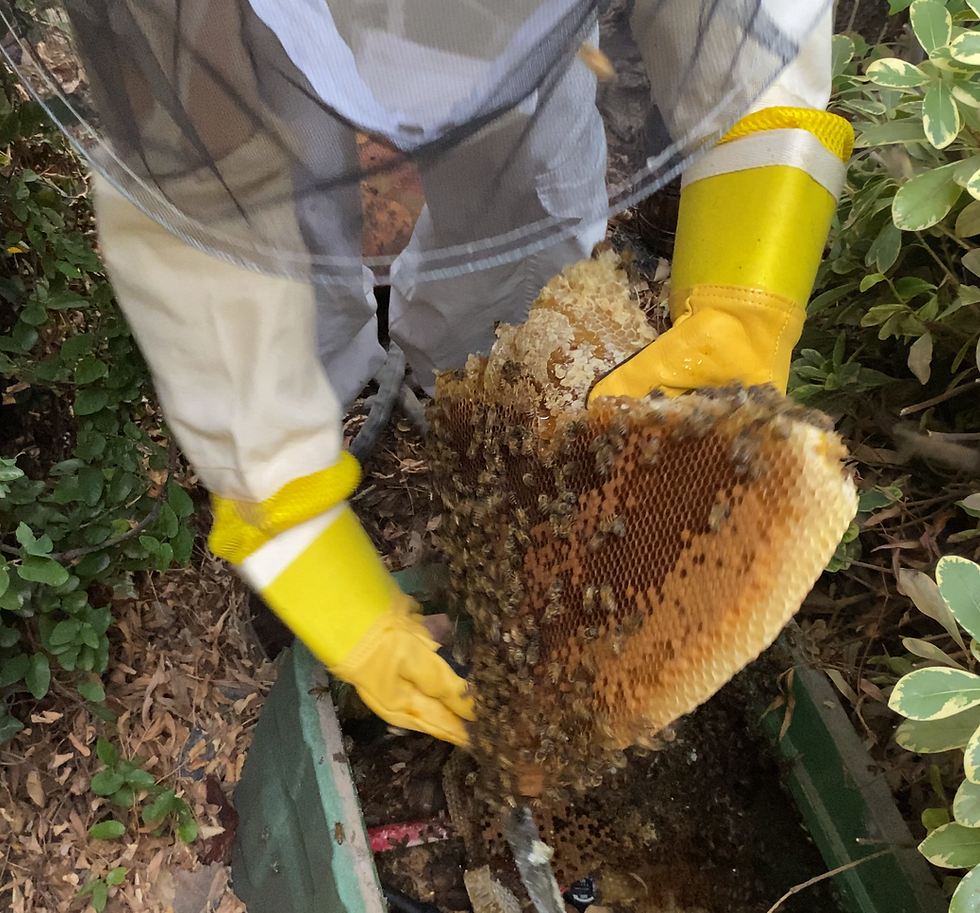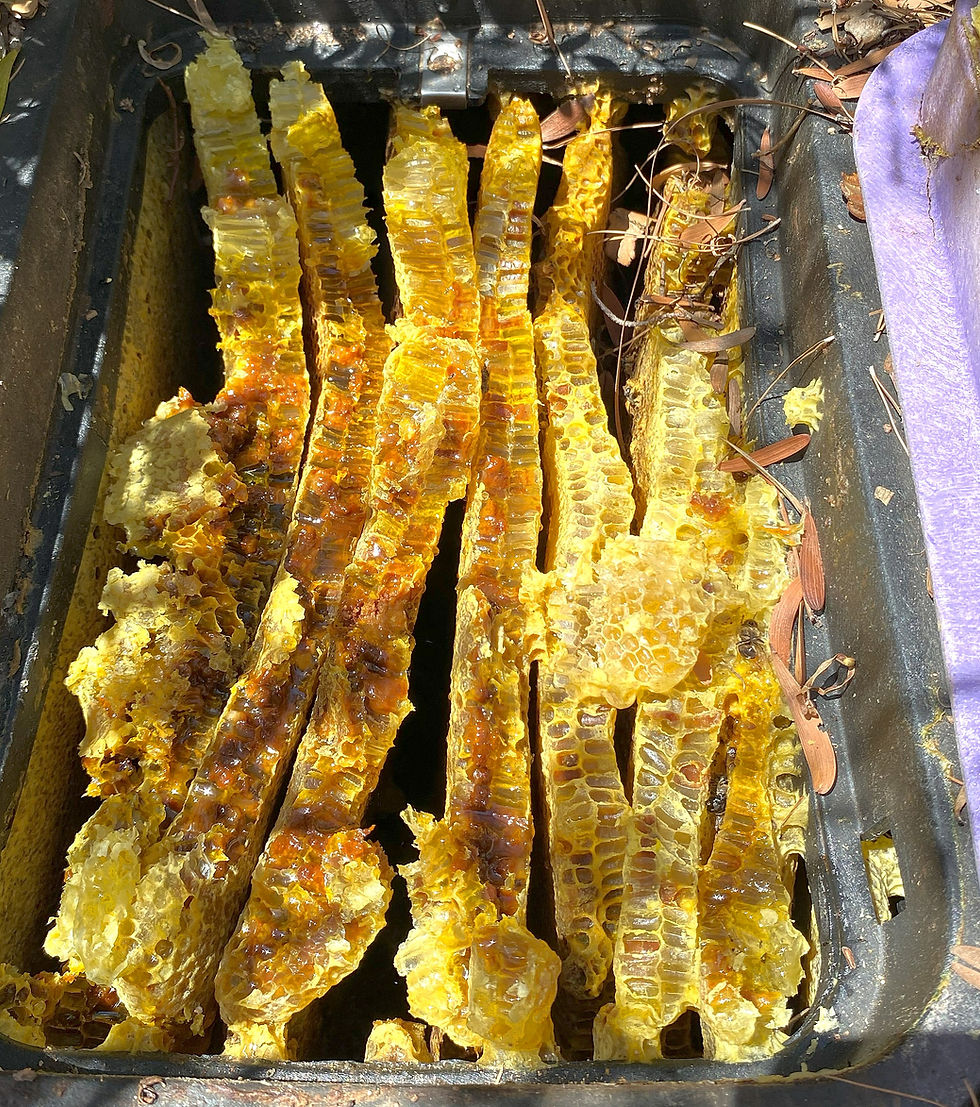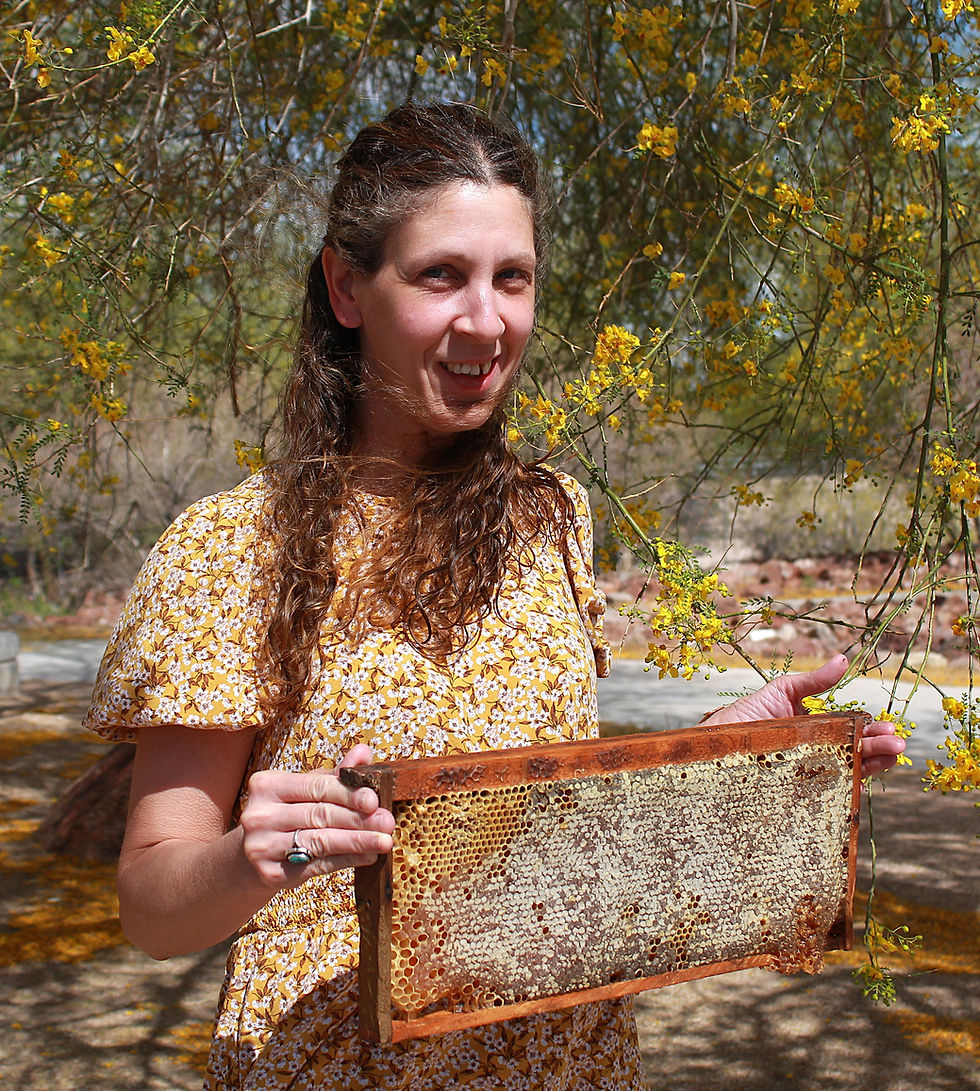Bees and Honey in the Old Testament Bible.
- Pete Rizzo

- Sep 27
- 12 min read
Updated: Oct 19

From My Hives to the Promised Land: Bees in the Old Testament.
Bees and honey buzz through the pages of the Old Testament Bible as symbols of abundance, sweetness, and community.
As a beekeeper I can’t help but smile at these images: watching bees returning to overflowing hives on a summer days make the promise of a “land flowing with milk and honey” feel vivid and real. But the Bible’s bee imagery wasn’t just poetic.
Archaeology confirms that ancient Israelites practiced serious apiculture. In Israel’s Beth-Shean Valley at Tel Rehov, excavators uncovered dozens of cylindrical clay hives arranged in neat rows.
Each three-foot tube had a small entrance hole for bees and a removable top for collecting honey. This “industrial” apiary from the 10th–9th centuries BCE could produce hundreds of kilograms of honey per year, showing that beekeeping was a real part of the economy, not just a passing fancy.
Archaeologists at Tel Rehov (northern Israel) unearthed ancient bee hives made of clay (10th–9th century BCE), demonstrating that Israelites tended hives on an industrial scale.
These finds overturn earlier ideas that biblical “honey” was only wild date-honey. In fact, Tel Rehov yielded not only empty hives but actual honeycomb fragments and bee remains. DNA analysis showed the bees were imported Anatolian subspecies, chosen for their mild temperament and high yields.
The people of Rehov clearly cared for these hives deeply, even building a special enclosure around them. (One modern beekeeper quips: “Of course they kept tame bees in town as wild local bees are cranky and low-yield!”)
The sophistication of this ancient apiary adds texture to passages like Exodus 3:8, grounding “milk and honey” in concrete reality.

The Sweet Economics of Honey
Honey in antiquity was a precious multi-purpose treasure. It wasn’t just table sugar, it preserved and healed. Its natural antiseptic qualities let people pack grapes, nuts or herbs into honey for long storage, guarding against spoilage.
Ancient Egyptian and Mesopotamian medical texts prescribe honey for wounds, coughs, and digestive ills, so the Israelite neighbors certainly knew its value. As a preservative, it stretched food through lean seasons. As medicine, it soothed and cured.
Food and medicine. Honey’s bacteria-fighting power meant it was both stored food and first-aid kit in one. Wounds treated with honey healed faster, and honeyed cakes lasted far longer than plain grain.
Trade and tribute. Caravans carried honey across deserts much better than fragile fruits. Indeed, the Bible notes that Israel traded honey internationally. In Ezekiel’s lament over Tyre, honey appears among Judah’s luxury exports: “they traded … honey, oil, and balm” for Tyre’s merchandise.
Archaeological finds like Tel Rehov help explain this: Israelite honey was plentiful enough for export.
Ceremony and hospitality. Although Leviticus 2:11 bans honey in Israelite burnt offerings, neighboring peoples did use it in their rites and sacrifices. More broadly, offering guests a sweet taste of honey (literally or figuratively) signaled wealth and welcome. A stream of milk and honey in a region meant good grazing and wildflowers, the best of human husbandry and wild fertility combined.

Honey’s rarity made it a luxury. Kings and nobles kept honey in ceramic jars or hollowed gourds – sometimes as part of a royal tithe. The fact that “milk and honey” are paired so often (over twenty times in the Hebrew Bible!) shows divine blessing as bountiful, layered blessing.
Milk (from well-tended flocks) and honey (from naturally blooming fields) together picture a land abundantly supplied by both human care and God’s goodness.
Rivers of Milk and Honey: The Promised Land
When Moses spoke of the future Promise, “a good and broad land, flowing with milk and honey” (Exodus 3:8), he meant a place of practical plenty and delight.
He wasn’t just daydreaming paradise – the hill country of Canaan really was rich in both flocks and wild bees. Limestone hills created countless caves and crevices for hives, and a rainbow of wildflowers all year long fed swarms hungry for nectar.
Early travelers could find honeycomb in rock clefts the way one finds spring water – as one Bible commentator notes, “bees abounded in Palestine, honey being a common article of food…often found in the clefts of rocks”.
For Israel, milk meant well-managed herds grazing lush valleys. Honey meant the spontaneous sweetness of nature itself. Together they promised sustainable abundance: pastures full of sheep and wild gardens where bees thrived.
This balance captures a key biblical idea: God blesses both our industry and the ungovernable creativity of nature. The Promised Land’s poetry reminds people that divine favor brings both cultivation and serendipity. One generation tends olive groves; the next finds wild honey to spread on their bread.

Samson’s Sweet Surprise
One of the Bible’s most vivid bee-scenes is also one of its strangest. In Judges 14, Samson slays a lion with his bare hands (you remember).
Then “after some days,” he returns only to find a swarm of bees and honey in the carcass of the lion. He scoops out the honey and gives some to his parents.
This incident becomes the basis for Samson’s famous riddle: “Out of the eater came something to eat; out of the strong came something sweet.”
At first read, it’s almost absurd: bees in a dead lion? But it’s actually quite natural.
In an arid climate, a fresh carcass can dry out completely in weeks, leaving a hollow shell with just bones inside. Beekeepers today still observe that wild bees will colonize any suitable cavity when tree hollows or hives are scarce.
A dry lion’s corpse would make a perfectly cozy hive. It would be warm, sheltered, and safe from rain. (Indeed, a 19th-century biblical scholar noted that Middle Eastern heat can “in the course of twenty-four hours completely dry up” large carcasses, leaving them odorless and fit for a swarm).
Samson simply stumbled on nature’s recycle bin: death turned to dessert.
The story works on several levels. Literally, it shows God’s providence providing the Israelites with honey where none expected it.
Samson, in no way a beekeeper, unexpectedly becomes a consumer of fresh honey from God’s hidden pantry. Symbolically, later readers found deeper meaning.
Early Christians even saw a foreshadow of resurrection: out of the lion’s “death” came sweetness, just as Christ’s victory over death brings the “honey” of salvation. More broadly, this scene illustrates a recurring biblical lesson: blessing sometimes hides in unlikely places.
As one commentator notes, the honey from the lion reminds us that God “can bring forth good from unlikely situations".
Even in battle metaphors, Samson shares the honey with family – a quiet symbol of generosity amid conflict.
The very bees, by turning a violence into sustenance, hint at nature’s resilience: life springs from death. For a modern beekeeper, this is all too familiar. We build hives and expect honey, but sometimes bees surprise us in life-and-death ways.
Samson’s tale reassures us that God can orchestrate even random acts of nature for future blessing.

Bees and Battle: Swarm Metaphors in War
The Old Testament also uses bees to describe armies. Anyone who’s seen a disturbed hive knows that hundreds of angry bees can chase an intruder a long distance – they’re tiny but coordinated. This makes them perfect images for united defenders.
Deuteronomy 1:44. When the Israelites were driven back by the Amorites, Moses reports, “the Amorites…came out against you and chased you as bees do, and beat you down from Seir as far as Hormah.” The Amorites are the swarm protecting their territory. The metaphor emphasizes numbers and frenzy: an advancing hoard of defenders, like enraged bees defending a hive. Each Amorite alone was no threat, but swarming together they routed Israel.
Psalm 118:12. “They surrounded me like bees; they went out like a fire among thorns; but in the name of the LORD I cut them off!” Here the psalmist pictures enemies closing in like a cloud of bees. Initially it sounds dire, but then like quick-burning thorn-bushes they vanish in God’s judgment. The verse contrasts the threat of the swarm with divine deliverance. The tiny, stinging enemies come en masse, but are quickly dealt with (the psalmist “cuts them off”). The bees metaphor again means relentless pursuers, yet ultimately powerless before God.
Isaiah 7:18. In a prophetic oracle, God says He will “whistle for the fly in Egypt, and for the bee in the land of Assyria.” This odd verse likens invading armies to insects. The commentary explains: the fly and bee are swarming insects that can get into any crack. Here the “fly” stands for Egypt and the “bee” for Assyria – major enemies. God will summon them as if calling swarms, using them as instruments against Judah. The images underline divine control: hostile forces are like trained swarms responding to God’s whistle, not random powers.
In each case, the bee imagery conveys coordinated, overwhelming force. But the context also reminds the faithful that even these buzzsaws are under God’s thumb. The Israelites learn: whether blessings or battles, God uses the natural patterns of swarms to make His points.
Wisdom and Honey: Sweet Lessons
Honey isn’t only about battle and bounty; the Hebrew poets used it to describe the sweetness of God’s wisdom. The ancients knew how delicious a teaspoon of honey could be, and they loved comparing God’s Word and wisdom to that pleasure.
Psalm 19:10. David sings about God’s law: “More to be desired are they than gold… sweeter also than honey and drippings of the honeycomb.” In other words, God’s commandments are richer than fine gold and sweeter than raw honey. He’s saying spiritual truth gives pleasure like tasting fresh honey right off the comb.
Psalm 119:103. The longest psalm is all about delighting in God’s statutes. The writer bursts out, “How sweet are your words to my taste, sweeter than honey to my mouth!” This intimate image turns study of Scripture into a feast: the lover of God savors each word as he would savor an exquisite candy. For someone raised on plain flatbread, a honeycomb dripping sweetness would be ecstasy – that’s how the psalmist feels about divine teaching.
Proverbs 24:13–14. The sage urges, “My son, eat honey, for it is good; and the drippings of the honeycomb are sweet to your taste. Know that wisdom is such to your soul; if you find it, there will be a future, and your hope will not be cut off.” Here honey-eating is literal encouragement to enjoy a treat, immediately followed by a spiritual truth: wisdom itself is as good and sweet to the soul as honey is to the tongue. Finding wisdom is like discovering eternal honey, ensuring a bright future.
Proverbs 25:16. Even in warning, honey teaches well. “If you have found honey, eat only enough for you, lest you have your fill of it and vomit.” Too much of a good thing can turn bad – honey is delicious, but overindulging makes you sick. The proverb uses this to teach self-control. Even wise pleasures must be enjoyed in moderation, or they’ll sour.

In all these passages, honey’s taste, value, and effects stand in for God’s Word. Because honey appeals to our senses, we immediately get the idea: God’s truth isn’t bitter duty, but a choice blessing.
Properly enjoyed, it nourishes us for life (as Proverbs notes, “your hope will not be cut off” when you savor wisdom). Yet, just as one must not gorge on honey, spiritual lessons must be taken wisely.
The Old Testament invites us to have a holy appetite – hunger for truth – and to find true satisfaction in God’s sweet teachings.
Prophetic Dreams of Sweetness
Even the prophets borrow bee-honey imagery when envisioning futures of abundance or naming tools of judgment:
Ezekiel 27:17. In the lament over Tyre’s downfall, honey appears among normal trade goods: “Judah … were thy traffickers; they traded … wheat … and honey, and oil, and balm." This normal mention tells us: before wars disrupted everything, Israelite honey was valuable merchandise abroad. In other words, honey was part of everyday prosperity, the kind a city like Tyre could count on from Israel. The fall of Tyre (and Judah) means even that sweet trade dries up.
Isaiah 55:1. Though it doesn’t say honey, Isaiah 55’s “free banquet” imagery resonates with the milk-and-honey tradition. “Come, buy wine and milk without money and without price” (Isa. 55:1) extends the idea of free abundance. It’s as if honey flowed with the milk. The passage celebrates a God who offers life-sustaining gifts freely, no purse needed, just as one once needed only effort (or none at all) to gather honey from flowing comb.
Joel 3:18. In the picture of restoration, the prophet declares, “Mountains shall drip sweet wine, and the hills shall flow with milk” (Joel 3:18). This recalls the old “milk and honey” language, but on steroids – not just milk, but also wine flowing from rocks. It’s a panoramic vision: even desert mountains miraculously pour out drink. The lesson: God’s renewal will be overflowing and joyous, transforming every corner of the land.
Across prophecy, honey and its cousins (wine, milk) symbolize good things finally freed to all. They remind readers that God hasn’t abandoned material blessings in favor of the purely spiritual. The same care that made bees yield comb and flocks yield milk is promised by the Lord Himself in the new age.

Lessons from the Hive
Putting all this together, a few themes emerge from the Bible’s bee-honey imagery:
Generous abundance. God doesn’t promise meager scraps but overflowing provision. A land of milk and honey isn’t just okay pasture – it’s copious pasture plus wild sweetness on top. Divine blessing is portrayed as exuberantly rich, beyond bare needs.
Attractive truth. God’s wisdom and word are meant to draw us in, not repel. The honey-metaphors teach that spiritual truth should taste good to faithful hearts. We shouldn’t swallow it out of obligation, but savor it. If our souls are healthy, scripture should be more delicious each day.
Community power. A single bee is small, but a hive defends mountains. Israel’s strength always lay in unity. The swarm images (military metaphors) highlight collective action: communities acting together have godlike strength, for good or for ill. Scripture often called Israel to stick together (“a cord of three strands…”), and the bee-hive illustrates that union.
Transformation and hope. The sweetest honey came from the dead lion. Life emerged from death. Psalmists and preachers remind us that God often brings beauty out of tragedy. The hive teaches us that loss can become legacy – disaster can drip with blessing if God intervenes. This deepens Old Testament hope: even in exile or defeat, God can produce a sweetness we never expected.
Stewardship and skill. The finds at Tel Rehov show that humans cultivate creation for good. God didn’t just give wild ambrosia – He gave brains to tend hives, breed bees, and harvest honey. Biblical blessing works through human skill and care. Just as the Promised Land’s fruitfulness depended on farmers and shepherds, its bees depended on careful beekeepers. We have a divine partnership: we do our part (plant seeds, tend animals, raise hives) while God showers the growth.
Creation as teacher. The Bible’s sophisticated use of bee imagery reminds us that observing nature is part of wisdom. Bees teach work ethic and cooperation, hives teach law and order. Using them as metaphors suggests that creation itself is a “book” through which God speaks. If the microcosm of the hive reveals God’s design, then caring for creation is not just charity – it’s listening to His lessons.

Legacy and Living the Lesson
The Old Testament’s honeybee images didn’t stay in antiquity. Ancient Jewish writers and Christian teachers picked them up in new ways.
For example, some Second Temple Jewish texts liken a righteous community to a beehive – each person a honey-producer through kind deeds. Philo of Alexandria (1st century) even wrote allegories on bees and honey, seeing them as symbols of the soul’s sweetness and divine reason.
Early Christians continued this tradition. The Didache (2nd century church manual) uses “honey and milk” imagery in baptismal teachings, linking the new covenant back to Israel’s promise and fertility.
Medieval monks loved bees as models of prayerful community: Saint Ambrose and others even wrote that hives mirror the Church – one Queen (Christ), humble workers, communal discipline, and spiritual fruit (honey) for the world.
Today, with bees under threat, these ancient texts have fresh resonance. Modern creation theologians point out: if the Bible depicts a healthy land as “flowing with honey,” then plummeting bee populations are a theological wake-up call.
Caring for bees and their habitats isn’t just environmentalism; it’s sacred stewardship in line with Scripture’s vision. When I tend hives or plant wildflowers, I feel connected to that ancient hope of abundance and to the One who said He provides for the lilies of the field.
The Old Testament’s bee imagery invites us into a partnership: we do our part to keep hives healthy and fields blooming, and God fills them with sweetness. That’s an invitation both practical and spiritual. It links millennia of faith – from Solomon’s gardens to Samson’s feast to today’s apiary – in one ongoing lesson.
As the ancient writers saw, bees and honey teach us about community, trust, and the character of God: industrious yet giving, orderly yet creative, sustaining yet surprising.
Ultimately, the bees of the Old Testament remind us that God’s blessings are both personal and worldly. They sweeten individual faith just as they enrich the whole land.
In my own beekeeping, I taste the legacy of this promise every spring. And when I share honey with friends, I pass along a taste of Scripture’s promise: life in the sweetest, most abundant way.
Betsy & Pete
🐝Las Vegas’s All-Natural Live Bee Removal Team
About Us: The Authors

We’re Betsy and Pete - Beekeepers on a Mission in Las Vegas
We’re not just in the bee business, we’re in the bee-saving business. Trained by a master beekeeper and backed by hundreds of successful removals, we are dedicated to rescuing and relocating honey bees with care and precision.
Every swarm we save and every hive we manage reflects our deep love for the bees.
At our Joshua Tree Preserve in Arizona, we care for dozens of thriving hives. Some wild, some honey-bearing, and all are part of our commitment to ethical, sustainable beekeeping.
Why Vegas Bees? Because We Never Stop Learning or Caring
Beekeeping is always evolving, and so are we. We stay on the cutting edge by continuing our education, connecting with fellow beekeepers, and refining our beekeeping practices and techniques to ensure the best outcomes for both bees and people.
Whether it’s advanced bee removal strategies or the latest natural methods, we’re always one step ahead.
We’re also proud to support the beekeeping community with high-quality beekeeping supplies for everyone. If you’re ready to suit up and start your journey, we’ve got what you need.
.png)


